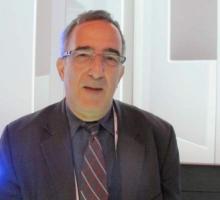Copenhagen – The experimental antibody-drug conjugate inotuzumab ozogamicin was associated with a nearly threefold higher complete remission rate than standard intensive chemotherapy in patients with relapsed/refractory acute lymphoblastic leukemia, investigators reported.
Among 218 patients in a phase III clinical trial, rates of combined complete remissions (CR) and complete remission with incomplete recovery of counts (CRi) were 80.7% for patients randomly assigned to receive the anti-CD22 conjugated antibody inotuzumab ozogamicin, compared with 29.4% for patients assigned to receive a standard intensive chemotherapy regimen chosen by investigators (P less than .001).
In addition, among patients who had complete remissions in both groups, significantly more patients in the inotuzumab ozogamicin group had fewer than .01% marrow blasts, a level below the threshold for minimal residual disease (MRD) (78.4% vs. 28.1%, respectively, P less than .001), reported Dr. Hagop Kantarjian, professor in the department of leukemia at the University of Texas MD Anderson Cancer Center, Houston.
“In my opinion, inotuzumab is well tolerated with appropriate prevention measures, and my hope is that soon in the future, inotuzumab will be used not as a single agent, but in combination with chemotherapy or with other monoclonal antibodies targeting CD19,” he said at the annual congress of the European Hematology Association.
Inotuzumab ozogamicin is an anti-CD22 monoclonal antibody conjugated to calicheamicin, a cytotoxic antibiotic. CD22 is expressed on the surface of about 90% of B-cell ALL cells.
Dr. Daniel DeAngelo from the Dana-Farber Cancer Institute in Boston reported that in the same cohort of patients, the first 218 of 326 randomized in the INO-VATE trial, , the co-primary endpoint of CR/CRi by independent review was achieved by 80.7% of patients treated with inotuzumab and 33.3% treated with standard of care.The updated data presented at the meeting also are published online in the New England Journal of Medicine 2016 June doi:10.1056/NEJMoa1509277 .
The phase III trial randomized 326 patients with relapsed/refractory CD22-positive ALL due for salvage 1 or 2 therapy to inotuzumab or standard of care, consisting of either the FLAG regimen (fludarabine (Fludara)/cytarabine (Ara-C)/granulocyte colony-stimulating factor), Ara-C plus mitoxantrone (Novantrone), or high-dose Ara-C. The starting dose for inotuzumab was 1.8 mg/m2/cycle and was reduced to 1.5 mg/m2/cycle once a CR or CRi was achieved. Patients were stratified by duration of first remission, salvage 1 or 2, and age.
The first 218 randomized patients were included in the intention-to-treat CR/CRi analysis, which was modified after excluding 13 patients who refused to start treatment, all in the standard-of-care arm.
The patients’ median age was 47 years (ranging up to 79 years), two-thirds were in salvage 1, and more than half had a remission duration of less than 12 months, an adverse prognostic feature.
Dr. Kantarjian reported that in addition to the superior remission rates seen with inotuzumab ozogamicin, patients on the antibody-drug conjugate had significantly longer duration of remissions, at a median of 4.6 months vs. 3.1 months for patients on chemotherapy (P = .003).
An intention-to-treat survival analysis including all 326 patients randomized in the trial showed that progression-free survival was significantly longer in the inotuzumab ozogamicin group, at a median of 5.0 vs. 1.8 months (hazard ratio .45 P less than .001).
Overall survival was slightly better with inotuzumab, at a median of 7.7 months vs. 6.7 months, but this did not meet the study definition of significantly improved overall survival with a pre-specified boundary of P = .014 or lower.
In the safety population, which included 139 patients assigned to inotuzumab and 120 to chemotherapy who had received at least one dose of the assigned regimen before data cutoff, the most frequent grade 3 or higher non-hematologic adverse events with inotuzumab ozogamicin were liver-related. In all, 13% of patients assigned to inotuzumab in the safety population developed veno-occlusive liver disease of any grade, compared with 1% of those assigned to standard of care.
“This drug showed consistently high activity in several studies, so I think it’s very exciting, The real challenge will be how to proceed, how to incorporate it into clinical trials both in pediatrics and adults,” commented Dr. Shai Izraeli, head of the section of functional genomics and childhood leukemia and cancer research at Sheba Medical Center in Ramat Gan, Israel. Dr. Izraeli was co-moderator of the late-breaking abstract session where the data were presented, but was not involved in the study.
He said in an interview that the challenge for investigators will be to develop clinical trials that combine this agent with different immunotherapies from different companies, which would be a logistical nightmare, “but I think we need to do it.”


